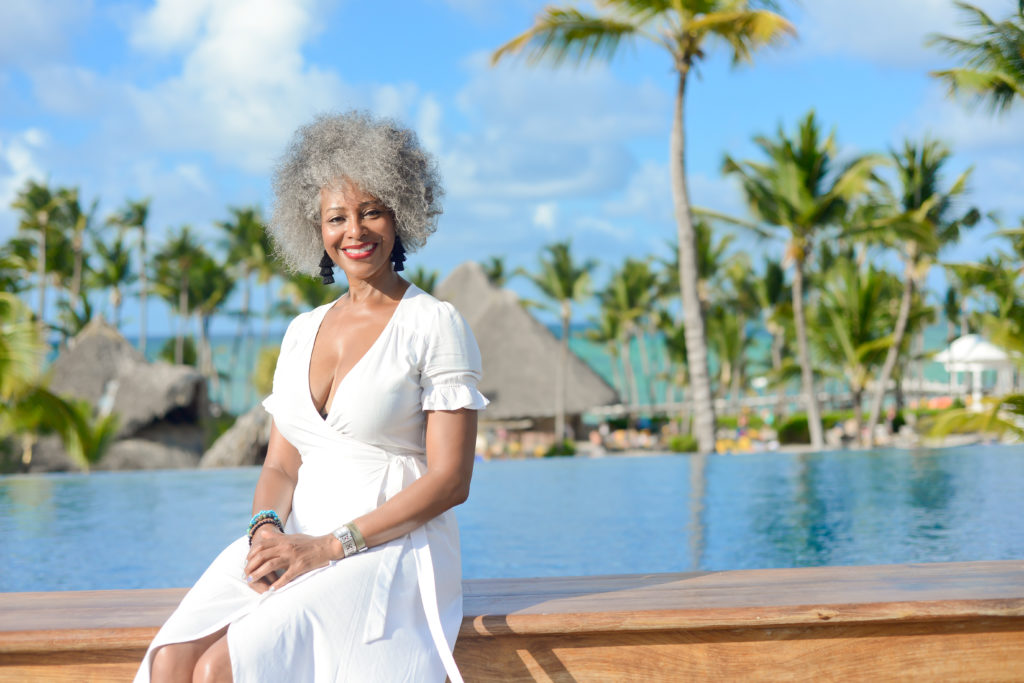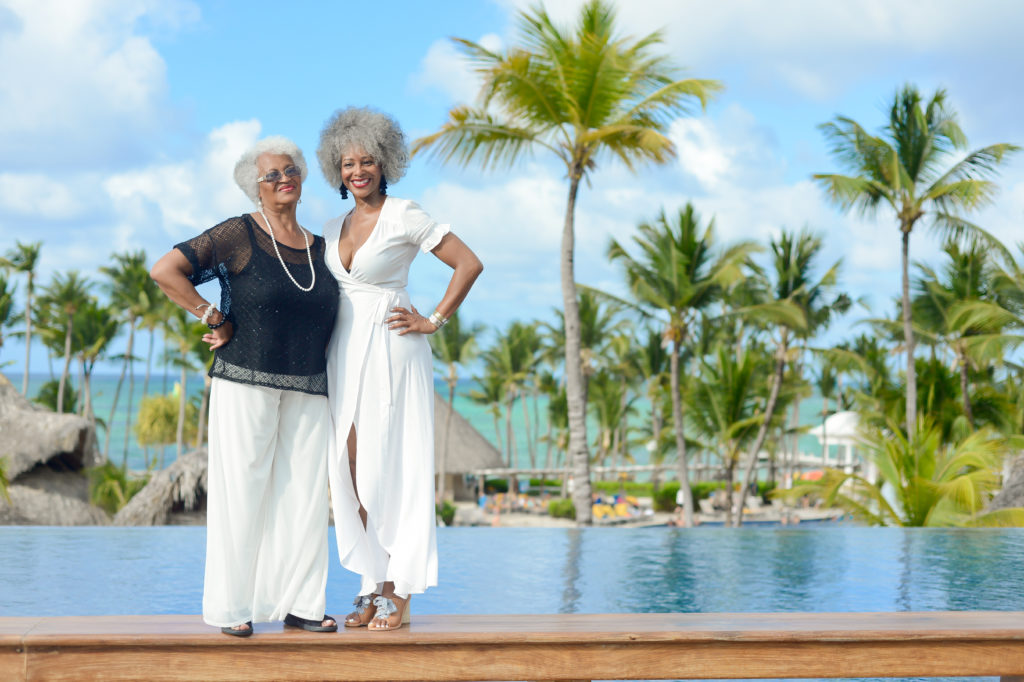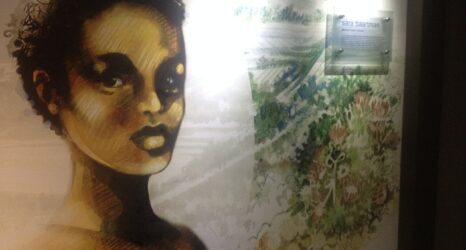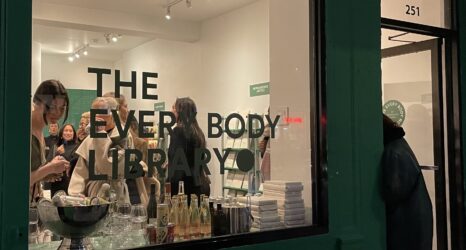Affixed to my refrigerator door is a photo taken of me last February with blaxploitation star Judy Pace, actress Mary Todd, “Band of Gold” songstress Frida Payne and singer Mary Wilson from the original Supremes. Four icons from the ‘60s and ‘70s now in their seventies—and me, twenty years their junior, the only gray-haired lady in the bunch.
My hair began prematurely graying when I was 17, and two years ago I listed “gray” as my hair color on my driver’s license the first time because my hair color is what people most often comment on when they first meet me.

Loving my hair has not always been easy, but embracing my “cloud,” as my girlfriend calls it, has made me feel special—“and you need to thank your Mama every day for that hair.”
I come from generations of women who grayed in their late teens and twenties, including my mother, her mother and her mother before her. Growing up, the old folks back in East Tennessee used to share stories of my grandmother who, by all accounts was “a beautiful woman,” with what they called, “good hair”—which she inherited from my great-grandmother, a woman of “Indian-blood” with fine wavy hair which she wore in a long-fat plait that grew so far down her back she could sit on it.
As a child sitting on the living room floor between my mother’s legs as she did my hair in front of the television, I dreamt of having the kind of hair that would make me pretty. Each night, Mom massaged my head anointing me with Le Conte Hair Conditioner Cream—a light pinkish miracle grease that promised to make it so. Having been born bald-headed, I was almost two before I had enough of a clump for my mother to clip a tiny plastic barrette around. It was my little brother, with his soft mound of ringlet curls, who inherited mother’s hair. She never called her own hair “good,” but it was pretty. And I envied him that. After all, what did a boy need with pretty hair?
By the time I started kindergarten, my twisted braids hung below my ears. I remember the odd sense of delight I felt turning my head from side to side—whacking myself in the face from the colorful barrettes that dangled from each twist.
With junior high school came additional length, and my hair brushed my shoulders. The taunts of my peers, however, confirmed for me that no amount of length would make my hair “good.”
I was “homely,” an “ugly duckling” with full lips and small almond eyes hidden behind large framed glasses—tall and gangly in my brand-less, discounted clothes. I wasn’t the girl who got picked to partner on the dance floor. I wasn’t the girl to get a second glance. Anxiety would become my hair’s undoing.

Mom would yell at me for digging in my head when she caught me wrapping the natty edges of my hair between my fingers which, over time, created bald patches. Most of the time I didn’t know I was even doing it, and felt bad that I couldn’t stop it—ruining her years of hard work coaxing my once stubborn hair follicles to produce.
On the advice of my father’s cousin, a beautician, my mother took me to get a jheri curl to keep me from “picking at it” in hopes it would grow again. After two years of oily collars and night’s sleeping with a thin plastic shower cap on my head, it eventually did.
By my senior year, I was allowed to make decisions about my hair. Once the curly ‘do was gone, I got my hair strengthened and cut into one of those gravity defying styles that typified a mid-80s coif: puffed up on top, tapered at the bottom—with bangs, where I noticed my first strand of white hair. I embraced the inevitable.
Why? Because with the time it took to make my hair “presentable”—from the two or three hours at the salon getting it washed, blow-dried; pressed and curled every two or three weeks to the nighttime roller regimen and morning styling—I didn’t want to spend any more time in the mirror hunting down stray grays to pluck them out.
I didn’t want to endure the endless hours in the salon getting my hair colored—even though a couple of my same-age girlfriends from high school suggested I should, for their sakes. They didn’t want to be perceived as old by association. I was in my 30’s when a U.S. postal clerk suggested I color my hair with black coffee when I explained I didn’t want to bother with chemical dyes.
“Why would you want your hair to make you look old?” she said.
Of course, I never saw it that way.
I like gray hair—and the women in my family wore it well. The summer before my first gray appeared, my mother had dyed her now snowy-white tresses, and looked quite … well, odd.
I returned from camp, barely recognizing her among the crowd of waiting parents; her otherwise bright face weighed down underneath a shadow of heavy inky-black hair. With my first gray sprout, I secretly hoped I would get a silver streak like one of mother’s cousins. I thought it was bold, mostly because it was unique.
Eventually, the strands of silver would fleck through my hair like tossed tinsel on a Christmas tree. Over the years, I’ve continued to get this shock and awe reaction that my “young-looking” face belies how old my hair “suggests” I should be. Funnier still are the comments from millennials and Gen-Zs who can’t believe my hair grew in this way—often mistaking me for a bottled silver fox trying to keep up with current hair fashion trends.
Even the pick-up lines from men focus on my hair. Instead of the, “Baby, what’s your phone number?” opener, it’s: “Sista, how’d you get so brave to let your hair grow out like that?” This eventually leads to an ask for my digits.
With women it’s mostly flattering things like, “I hope my gray looks like yours someday—whenever I get around to letting it just go.”
We all want to feel young, attractive and relevant. We all want to be seen— and looking at the photo with the brunette-haired divas, I definitely stand out. Thinking back, I often did: Whether it was writing and performing an original composition for my junior high school talent show, managing the high school newspaper or directing my church’s youth choir.
I’m now 52, and I see the gift of my gray hair having been more empowering than any container of Le Conte: that owning one’s self is not simply noble, or fiercely courageous—but beautiful.
Thanks, Mom.





